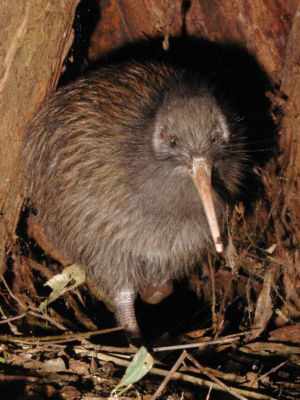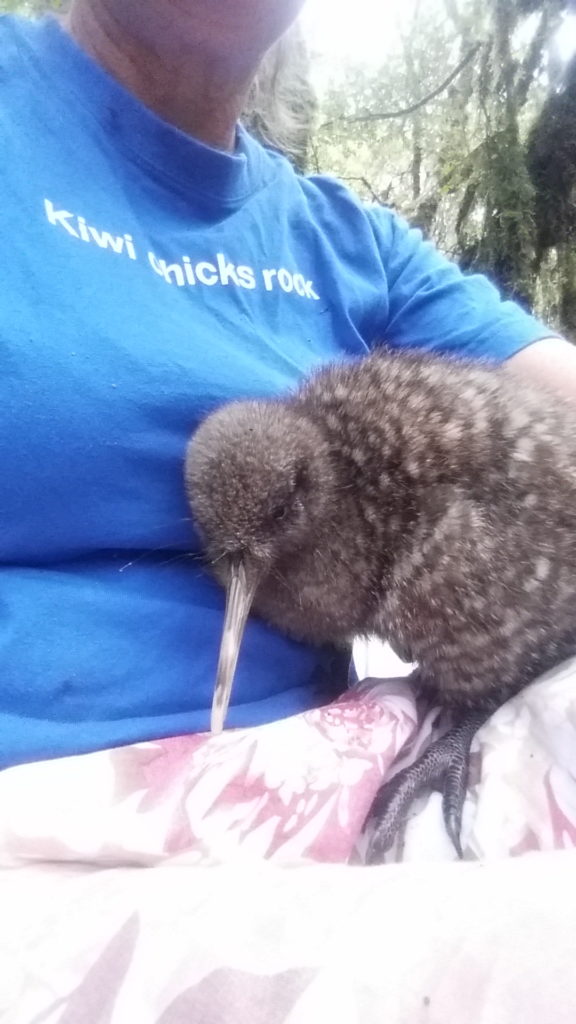Kiwi call counts are an important monitoring tool in kiwi recovery projects, but just how accurate are they? The time of night you choose, the weather, the season and other environmental factors can all potentially affect kiwi calling and best practice recommendations have been formulated to reflect this to some extent.
So how much influence does time and environment have over kiwi monitoring results and is it consistent between different kiwi species?Department of Conservation scientists, Rogan Colbourne and Andrew Digby investigated these issues and their peer-reviewed research paper is freely available on DOC’s website as part of its Research and Development series.
Kiwi are well camouflaged and hard to see – made even harder by their nocturnal natures, but a surprising amount of information can be gained by listening to their calls, making kiwi call monitoring an important evaluation tool.

“Kiwi… have extremely loud calls that can be heard up to 1.5 km away, which reveal information about not only their presence and gender, but also, potentially, their age class (subadult or adult) and/or individual identity. Generally, chicks and juveniles do not call.”
What do we know about when and why kiwi call?
“Kiwi begin to call when they emerge from their burrows or shelters soon after sunset and continue to call very occasionally/sporadically until sunrise, when they return to their burrows to sleep. True pairs of brown kiwi (Apteryx mantelli) often duet, with one calling immediately after their partner has finished, or sometimes by overlapping or alternating with their partner; and, in some instances, this can trigger a wave of calling from nearby territorial pairs. By contrast, there is more overlap in the calls of a true pair of great spotted kiwi (A. haastii). Kiwi calls primarily serve to maintain territories, but also help to maintain the pair bond and contact between mates – and in great spotted kiwi, which share the incubation of eggs, provide information on the location of the partner who is foraging/incubating.”
Acoustic recording devices are now available to monitor kiwi calls, but to date they are not as accurate as human observers in detecting calls in ideal environmental conditions. Human observers do tire, however, and this can affect results as the night – or week of nights – goes on. Technology is improving all the time and sensors offer the advantage of being able to be out in the field for extended research periods in all weathers with only the occasional need to replace memory cards and batteries. They can be left in place for weeks, months or even years – more than can be asked of even the most dedicated kiwi scientist or conservation volunteer!
“Recent rapid developments in the technology of automated acoustic recording devices have allowed acoustic data to be collected with much greater efficiency, providing much promise for this type of monitoring work. However, the optimal method of deploying recorders is unknown for most species. Therefore, this study aimed to improve our understanding of the calling behaviour of kiwi in relation to temporal and some environmental parameters, to help determine the most effective protocols for acoustic monitoring of their populations. This study primarily focussed on populations of brown kiwi, but a population of great spotted kiwi was also surveyed to determine whether the findings could be generalised to other kiwi species.”
Six ‘Song Meters’ (Wildlife Acoustics, USA), were used in the extended research project deployed at five North Island sites for brown kiwi and one South Island site for great spotted kiwi.
“The Song Meters were placed on ridges to gain the maximum listening coverage but were positioned away from the prevailing wind to minimise weather interference. They were set 1.5 m above ground level, screwed onto trees that were no more than 20 cm in diameter and away from forest epiphytes that could cause rustling noise in the wind.”
Recordings were conducted from sunset to sunrise on each night for periods ranging from 8-22 months.
“Two of the Song Meters were calibrated side by side with a person listening for 2.5 hours and 2 hours, respectively, on calm, dry nights. Calibration using trained listeners showed that the Song Meters detected 75% of calls heard (33 out of 44) at Hodges Bush and 73% of calls heard (11 out of 15) at Trounson.”
Recordings were made over 150 to 562 nights, with over 60 000 calls detected across all six sites.
“The call rates of both brown and great spotted kiwi males and females showed significant variation with time of year and time of night. At all sites, there was a strong association between the timing of peak calling for males and females in terms of both time of year and time of night, although male call rates exhibited larger seasonal fluctuations.”
For brown kiwi, the early part of the night was confirmed as the time for peak calling, however there was seasonal variation associated with breeding.
“This was best demonstrated by the clear repeated peaks in calling at Hodges Bush immediately before the June–July egg-laying period. The other brown kiwi sites also showed similar seasonal peaks… In all brown kiwi populations, peak calling usually occurred in the first half of the night for both sexes. However, calling occurred later in the night during the main incubation periods.”

Great spotted kiwi may need their own ‘best practice’ manual for call monitoring, however, as they were shown to behave quite differently for North Island brown kiwi populations. Those monitoring GSK calls may need to get up very early or stay up very late to catch the birds at their most vocal!
“Great spotted kiwi exhibited a very different calling pattern from brown kiwi, with calls
demonstrating less seasonal variation and poor repeatability from year to year, and call ratespeaking in the second half of the night.”
The researchers also found some influence of moon phase on kiwi calling in both kiwi species. The effect was only significant for females however. Heavy rain was found to mask the detection of kiwi calls by the acoustic monitors – a result that was expected by the researchers. While this does limit the accuracy of the devices in bad weather, the average human volunteer or researcher is unlikely to be happy in such weather either!
Estimating numbers of males and females in a population from call monitoring results isn’t entirely straightforward as males were confirmed to call more than females – and the extent of this difference varied between locations.
“Male brown kiwi call rates were significantly higher than female call rates at all sites, but ratios varied from 2.56:1 at Whanganui to 5.92:1 at Trounson. The sex ratio of adult males and females has been found to be close to unity at Hodges Bush and Trounson and so the lower detection rate of females was presumably due to them calling less frequently than males rather than them being at lower abundance. Therefore, since females are generally harder to detect, listening periods need to be long enough to detect most females resident within calling range, especially in low-density populations.”
There is, however, more equality among the sexes with great spotted kiwi – at least when it comes to calling frequency.
“Unlike brown kiwi, there were no sex biases in call rates for great spotted kiwi, which is in accordance with results from human listening records. A total of 942 hours listening resulted in 1168 male and 1107 female calls heard, which equates to a male to female call ratio of 1.1:1.”
The researchers conclude with some recommendations for future kiwi monitoring.
“Since brown kiwi call rates vary at different times of the night during the breeding period, we recommend that all new brown kiwi populations be monitored between May and July, to avoid monitoring during the second half of the incubation period. Thus, for brown kiwi, we recommend that existing monitoring continues to follow the best practice promulgated by Robertson & Colbourne (2003), i.e. monitor populations between April and June, away from the full moon (because females in some populations are affected by the full moon), and avoid windy or rainy
nights.”
“For great spotted kiwi, we recommend that call count monitoring take place between January and April, away from bright phases of the moon, and excluding windy or rainy nights. The highest call rates are recorded in the last 3 hours before dawn, but this is not a practical time for people to listen if a mix of humans and acoustic recorders are being used. Therefore, we recommend staying with the conventional listening period of the first 2 hours after civil twilight ends (45 minutes after sunset).”
They also issue some words of caution regarding interpretation of kiwi call monitoring results.
“As a result of the extreme seasonal variation from one year to the next at some sites, we caution against comparing counts over just a few years. There are good seasons and bad, and so sites need to be surveyed a number of times and the results averaged to obtain meaningful monitoring results. In addition, over the course of a night, kiwi calls tend to be clustered rather than spread out evenly, meaning that counts that are made over short periods are likely to produce highly variable results.”
Are acoustic recorders the way to go? There are certainly advantages, but also some limitations.
“The main advantages of acoustic recorders over human listeners are that they can record much more data at much less cost for much longer periods each night and for weeks on end. Acoustic recorders can also detect calls under poor conditions of wind and rain, when humans may struggle due to the low-frequency noise overwhelming the senses. However, the acoustic recorder used in this study (Song Meter SM2+) is not currently as good as a human ear under ideal listening conditions. If acoustic devices are to be used as a tool to monitor long-term changes in populations, it is vital to calibrate them against different models or brands so that better designs and specifications through time do not get mistaken for improvements in the population under study.”
The full peer-reviewed research report is freely available on the Department of Conservation’s website.

